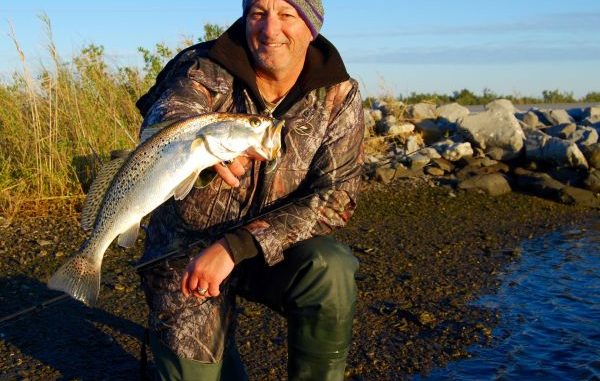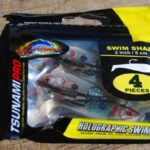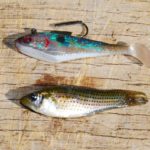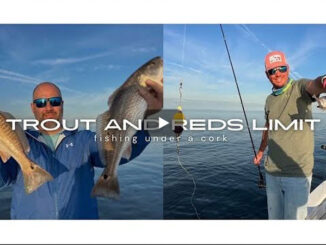
Vidrine suggests MirrOdine Mini, 2-inch Tsunami swimbait for more roadside specks
If you want to be a true wintertime Highway 1 roadside warrior between Fourchon and Grand Isle, you have to be properly equipped to do battle against the speckled trout located within casting distance of the road.
For angler Tommy Vidrine, that means bundling up in layers, wearing felt-bottomed hip boots for traction on the rocks, using lighter line for increased casting distance and smaller-than-usual lures to capitalize on the specks’ penchant for not passing up an easy meal in chilly conditions.
Vidrine, an independent contractor for Aflac well known on the island for his relentless year-round pursuit of trout, even perches himself on the bases of Highway 1 bridges leading into Grand Isle— literally only about 5 feet from traffic blowing by at 55 mph — to position himself properly with the wind and the current for a cast that might produce a speck.
Oh, and if you want to really maximize your chances at filling up your 5-gallon bucket, don’t plan a trip on a nice winter day.
For Vidrine, inclement weather typically means a good bite.
“The coldest, nastiest days should be the time when people want to plan a trip. It’s almost like duck hunting on the side of the road,” Vidrine said with a chuckle. “You want it cold and gray, with a 25 mph wind from the north or northeast.
“If it’s a south wind and it’s 70 degrees, you’ll catch a few here or there. When it’s warm, you want to focus on the bridges and local spots like the Culvert, not places like the Forbidden Hole or the Snake Pit – any one of those sand pits that have depth along Highway 1. The trout come in the holes for refuge from the cold, so it needs to be 45 or 50 degrees for a few days. But if it gets to 70, they’re leaving the holes for the marsh or the canals.”
A strong north or northeast wind is key for Vidrine, and not only because it assists with long casts south of the highway.
“When it’s blowing 25, the wind muddies up the water in the marsh everywhere except right along LA 1 because the highway is blocking it,” he said. “So the water is crystal clear there, and those fish still want to eat, so they come in there because it’s muddy everywhere else.”
Speaking of eating, Vidrine has a brand new bait in his arsenal this year that has proven particularly effective for speckled trout: MirrOlure’s MirrOdine Mini suspending twitchbait, with a black back and red stripe underneath.
“It’s an awesome little bait. This is the first year I’ve used that small of a bait. I used to use the MirrOlure Catch 2000 to catch bigger fish, just not as many,” Vidrine said. “But this little MirrOdine catches 12-inch fish and 20-inch fish.
“It’s easier for them to put their mouth on. And a slow retrieve has been better than a twitch. It’s a twitchbait and you’re supposed to jerk it, but a slow, slow retrieve on a cold, cold day really works.”
When he’s not throwing the MirrOdine, Vidrine usually opts for a small 2-inch Tsunami Pro swim shad. It only weigh an eighth of an ounce, so casting it isn’t particularly easy, especially in the wind. Vidrine recommends lighter line – 10-pound at most — and an ultra-light spinning reel if you don’t want to worry about backlashes.
Like most wintertime fishing, the key is patience and keeping things slow. In his experience, the smaller Tsunami catches more fish than the larger 3-inch size.
“You have to let that bait sink. Most people fish too fast, especially in the winter,” he said. “You can probably fish at half the speed you normally would. You can’t hardly go too slow unless the bait is just stopped, sitting there.”
Vidrine loves the Tsunami for its realism and action: Even though it’s relatively small, it perfectly mimics a potbelly minnow found in the marsh.
“I think it swims better than any other swimbait. The Tsunami just swims perfect,” Vidrine said. “I think the trout are not eating as much because they don’t have to exert a lot of energy right now. A fish is a cold-blooded animal, so its body temperature goes down with the water. When their temperature goes down, they don’t do much or eat much.
“So when that little snack passes by them, I think it gets them mad more than anything. It teases them with that little thing swimming past their nose. When you swim that bait through the water, you’d swear that it’s live. And fish see the same thing we see — it looks real and natural to them, so they eat it.”
Having a couple of lure options for different conditions gives you a better chance to catch more specks along the roadside, he said. As always, the presence of baitfish and cormorants feeding — along with lots of cars parked along Highway 1 — are indications the bite is on.
“You have to diversify. Don’t fish just one bait,” he said. “Some people catch two or three trout with a 3-inch swimbait and never try anything else.
“When they’re biting on everything and everybody is catching them, you can throw anything at them. But when they don’t want to bite and you don’t see many people catching, these lures work. Even when they’re not biting, I’m making them bite and catching fish every time I come.”






